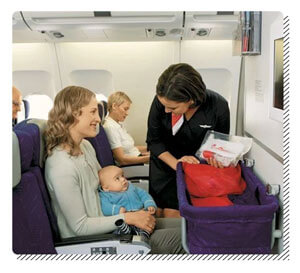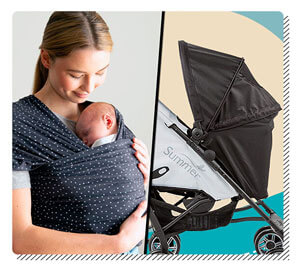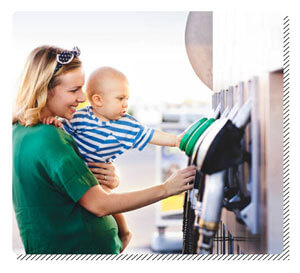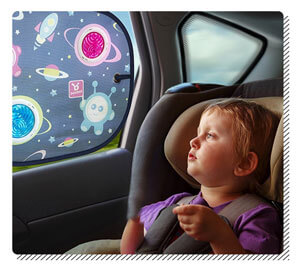Tips for Traveling with a Newborn Baby on a Flight or in a Car

Tell us, what according to you is the most annoying thing about traveling via a flight? Undoubtedly, it’s hearing the sound of a noisy baby around you. But what if that baby is your own? Yes, you definitely don’t want to be one of those parents. That aside, flights can be an uncomfortable experience for small children.
Similar to planes, cars can be quite the hassle for babies as well. Since they’re not accustomed to long distances, cars can just look like enclosed spaces for them, resulting in their discomfort. The space in your car may seem cramped as well, which is why you might have a fussy baby on your hands while taking a road trip. So without further ado, let’s dive into a guide on traveling with an infant.
Tips for Traveling with Baby on Plane
So why are planes such a terrible experience for children? Well, their ears are not accustomed to air pressure, just like ours, and they express their discomfort by announcing it to the entirety of the airplane while wailing.
Luckily, there are a few simple steps that you can take to ensure that your baby is travel-ready and you’re not inconveniencing any of the other passengers who probably just want to take a nap. Traveling with a baby on a plane might look like quite the task, but with some reminders, you’re all set to take that family vacation that you’ve been planning for all this while.
1. Babies should have a passport too!

A lot of people don’t know this but your little one needs a passport to be traveling overseas as well. The processing time of passports can take quite a while, and it’s usually an indefinite process, so it’s recommended that you get the documents in order well before taking the trip. The trickiest part of this whole process can be getting their photo taken – and if you’re a new parent, you know how difficult it is to get your little one to stay still for any period of time.
After you brave through that you will have to get various other documents in place for the application process – trust us when we say it’s exhaustive.
But this is often the first step to planning any sort of family vacation, and it will be the most important form of identification for your baby.
2. Book a direct flight or one with a longer layover
One thing we can say for sure: babies hate being jostled around. With all your luggage and an infant in tow, there will be plenty of jostling if you’re not wise with your choices. It is best to book a direct flight to your destination. Or if you’re traveling internationally or to a location that doesn’t offer you a direct flight, we recommend you pick a flight with a longer layover. The one with the direct flight is kind of a no-brainer – we want to spend as little time as possible with a cranky baby who can potentially explode into wails at any time.
A longer layover might help the jostling situation – it gives time to the baby to settle so that they’re not frustrated at the constant movement. You can also take this time to take your baby to the restroom, change their diapers, feed them – all tasks that are exponentially harder when you’re on the plane, so make good use of this layover!
3. Get the aisle seat

This step is absurdly simple yet quite forgettable as well. If you’re a parent with an infant, you do not want to be caught in the middle of two passengers. For all parties involved, it is best that you pick the aisle seat to avoid any mishaps and annoyances.
You may also have to get up quite a bit if your baby is uncooperative and walk around with them, so this step is crucial while traveling with a newborn. Your seat needs to be easily accessible since you have to be on your toes pretty much all the time.
4. Avoid any baby hammock for flight travel
While baby hammocks may seem like an affordable ad convenient solution to most of your baby travel solutions, deeper research shows that it might actually be unadvisable to invest in baby hammocks for flight travels. Not only do some airplane companies ban bringing baby hammocks onboard (and for good reason), they may be increasingly inconvenient for you and your baby.
Baby hammocks do not offer the baby adequate space, in which case they will feel stifled and hate air travel even more. Most flights do not have enough space to situate a baby hammock, which is why it’s a total no-no to invest in them. You can read more about this topic in our separate guide here.
5. Request an empty seat next to you on the plane

It may be best to request an empty seat next to your seat on the plane, if available. You can also opt to pre-book an extra seat for your baby, as keeping them in your lap, especially for long periods of time, maybe quite exhaustive for you.
With an empty seat, you can bring along your car seat or bassinet and install it so that your baby can have an easier time. And you won’t have to strain those muscles trying to keep your baby fixed on your lap all the time.
6. Check for the recommended travel vaccines for your baby
This one is an important step that people forget very often as well. Your child will have to get the vaccines mandated by the CDC for the country that you’re going to be flying to. You definitely don’t want to miss this step so apart from checking the list, you might want to visit the pediatrician who will be responsible for giving you further healthcare tips for traveling with a baby. You can double-check your vaccine knowledge there as well.
7. Make sure to pack baby’s medication

If your child is currently on any medication, then you will definitely remember to bring their supplies with you. For precautionary purposes, however, you need to pack all the regular medication – for digestive, respiratory, or common cold issues.
It is important to stay protected against all possible forms of problems that your baby may face. Talk to your pediatrician about any further precautions you need to be taking based on your baby’s health – we don’t want your child to fall ill in another country, as getting familiar with healthcare there will be a difficult issue.
8. Protect ears when flying with a baby

For adults and children alike, air pressure can be a real problem. Even with years of experience under their belt, adults can sometimes not get used to the discomfort of popping ears and experience waves of nausea.
Well, it’s definitely worse for your baby. Their ears may experience constant popping and they will most likely find it extremely uncomfortable. It is important to protect your baby’s ears when you’re flying.
A hack you can try is hydrating your baby with small sips of water – not too many, lest they need to change their diaper much quicker than expected – since swallowing often does the trick with releasing air pressure.
9. You can Buy diapers at your destination
Whether you’re electing a direct flight or one with a long layover, we assure you that you will be able to buy diapers at your destination. Duty-free stores at airports, while overpriced, are fully stocked for emergencies such as this.
In your destination country as well, diapers are an abundant resource that you will not run out of. When you feel like you’re running low on diapers – don’t panic and wait calmly for your destination or layover.
10. Choose between a Baby Sling or a Compact Stroller

It is important to think about how you’re going to be carrying your baby when you’re not on the plane. A definite no-no is carrying your baby with your arms all the time. It can get tiring for both you and the baby, so you should most likely invest in a baby sling or a compact stroller. While both of these are strong contenders for baby travel while on land, they both come down to your needs.
Baby slings are useful if you don’t want the hassle of checking in an extra item, while strollers can be useful for maximum comfort and familiarity for your baby. Some countries aren’t optimized for stroller use, so keep that in mind!
Stroller at the Airport
Yes, you will have to check in your baby’s stroller as well. And no, it requires no additional cost to do so. If you have a large stroller, then chances are that you’ll be asked to check the stroller in through the ticket counter. Mostly, however, your stroller can be checked in through the gate or the curb.
The gate check-in is the best idea since it allows you to utilize your stroller when you’re going around the airport. Most airports are extremely large and carrying a baby with all that luggage may prove to be a hassle without the assistance of a stroller.
Tips for Traveling with a Baby in a Car
Similar to planes, traveling in a car with a baby can be a difficult task for everyone involved. For you, it’s the stress of keeping your baby entertained and preventing a meltdown at all costs, For your baby, it is hours of movement that can result in boredom and carsickness.
It is important that your baby’s needs are kept in mind so that your road trip can be a fond memory for your family. Here are a few reminders that you need to keep in mind while journeying via road with your baby, because things might get a little bumpy!
1. Take enough breaks

This is a simple solution for everyone who is traveling by a car for long distances, and especially for your baby. Taking enough breaks ensures that not only you can stretch your legs farther than the car’s gear, but your baby’s possible nausea can be kept at bay.
With enough breaks, your baby can have the chance to stop and breathe, and the monotony of the journey will not get to them. You can even make these breaks fun by letting your baby explore the environment surrounding your car.
2. Get a Car Seat for the baby

This step is the most important part of traveling with your child via a car. If you hadn’t already, you might want to invest in a car seat that can hold your children when you’re traveling any sort of distance by road.
Car seats are great for keeping your baby in place, as we definitely don’t want them gallivanting off on all corners of your vehicles. If your baby is in a car seat, it reduces the risk of injury with sudden brakes. A tip, however, would be to get a car seat that can clip onto your stroller – this makes sure that you don’t have to put up with the extra hassle of having a car seat with you everywhere you go.
3. Get Sun Shades for the baby

Sun shades can be incredibly useful for your baby – especially if you’re going to be traveling by car since they’ll spend a lot of time looking at everything that’s around them. More than likely, bright lights might hurt their eyes so it is best to be keeping sun shades on your car at most hours of the day.
They also insulate the car from heating up too much, so really it’s double the investment. With sun shades, your baby will definitely not have to squint out at whatever is outside the window – they can do so through the safety of your sun shades.
4. Stock up all the baby essentials

Lastly and perhaps most importantly, you’re going to need to stock up on all the essentials that you think you can possibly need on a long road trip. This includes diapers for those emergencies, pacifiers, favorite toys, baby formula for meals (and extra, if you want to be sure), water, change of clothes, breast pump – you name it.
Road trips can be difficult to prepare for even if you’re an adult – and it’s doubly more so with children. But by making a mental checklist, you’ll have this down in no time!
Our Advice
While it definitely looks like traveling with a baby may mean absolute doom for you for a few weeks, we assure you it’s worth it. Taking them on their first family vacation is something that will be a memory for the photo albums for decades to come. And as you have seen, it’s really not as difficult as it may seem.
All you need to do is be patient and keep your mind open to learning – chances are the more frequently you travel, the more proficient you will get at taking your baby places. With the right gear and the right baby supplies, we assure you that you’re more than set for that perfect journey across the roads and seas. Happy vacationing!

Laura is a trained primary teacher who takes a profound liking in interacting with and bringing out the best in children. She is also an ISSA certified pediatrician with an extensive practice of over 12 years. Laura comprehends the needs of infants and now compresses her expertise into writing thorough parenting guides to aid new parents.






